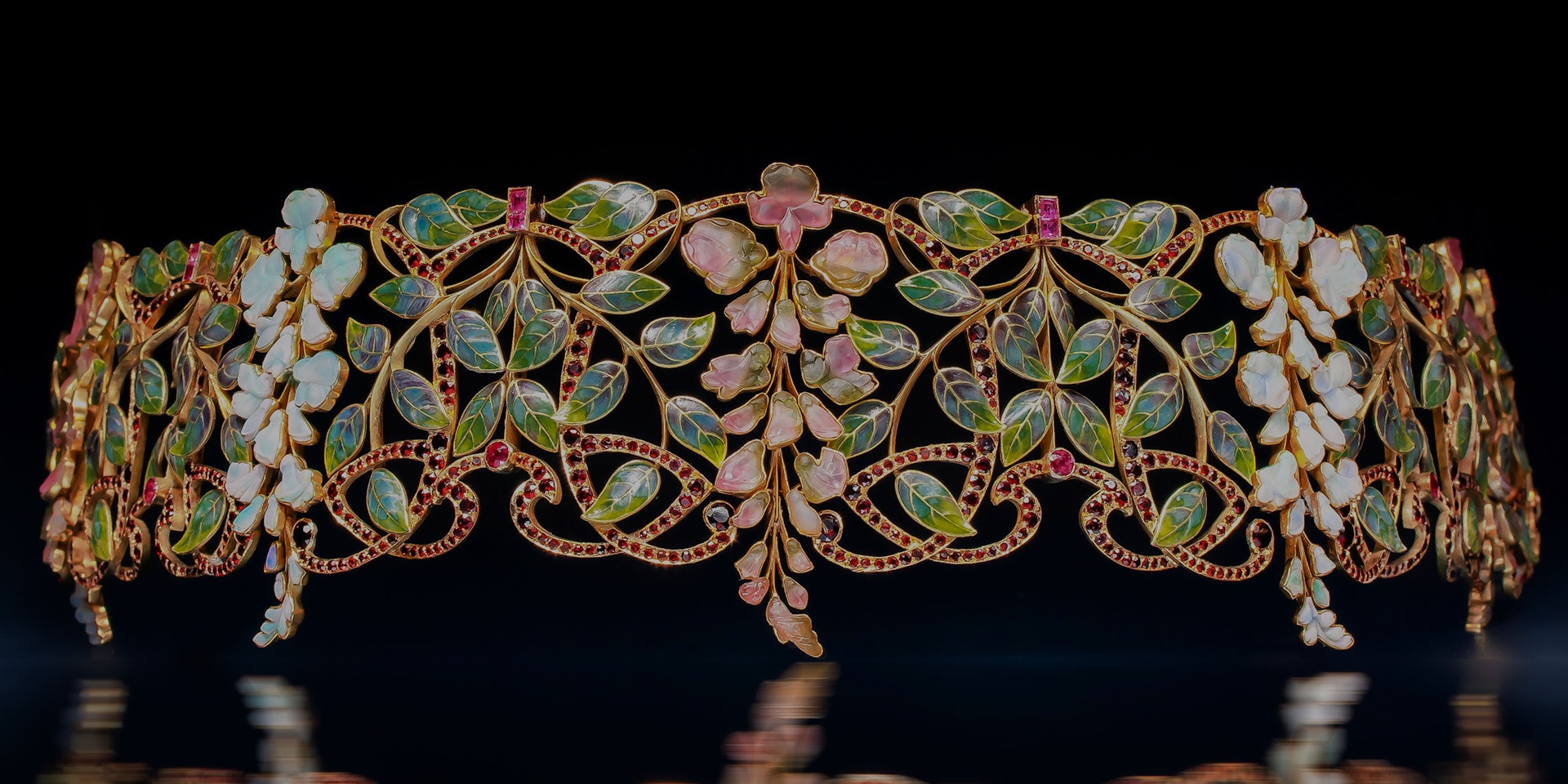
“A Curator’s Dream”: How a Belgian Art Nouveau Choker Found Its New Home in the Virginia Museum of Fine Arts
Acquired at TEFAF, the one-of-a-kind Wisteria “Glycines” Choker is indisputably jewelry designer Philippe Wolfers’s most important creation
- By Stephanie Sporn
- Museum Stories
After a decade of searching, Virginia Museum of Fine Arts curator Barry Shifman has made one of his most significant acquisitions yet. As the VMFA’s Sydney and Frances Lewis Family Curator of Decorative Arts, 1890 to the Present, Shifman oversees the museum's Arts and Crafts, Art Nouveau, and Art Deco collections, which are among the finest in America. Upon joining the VMFA 14 years ago, Shifman found there was already a strong selection of jewelry by famed French glass artist, René Lalique (1860–1945). When it came to representing other European Art Nouveau jewelers, however, he identified a major gap, and only an absolute showstopper by Belgian artist Philippe Wolfers (1858–1929) could fill it. It was at TEFAF’s 2019 fair in Maastricht that the curator came face to face with Wolfers’s 1900–1902 Wisteria “Glycines” Choker, a treasure that was more than worth the wait.

“Not only did I get exactly what I wanted, but I never had imagined something so grand, splendid, and unique.” — Barry Shifman
“If you can only acquire one piece by Wolfers you better get it right, and I was never going to find anything better. I just had to get it. I was possessed,” Shifman tells TEFAF of the sinuous design, comprised of watermelon tourmaline and opal wisterias, complemented by purple and green plique-à-jour enamel scrolling leaves and garnet and ruby accents. “Not only did I get exactly what I wanted, but I never had imagined something so grand, splendid, and unique.”
Shifman acquired the object from Belgian exhibitor, Epoque Fine Jewels, who first presented the choker at TEFAF Maastricht 2018. Patricia De Wit, co-owner of Epoque Fine Jewels, had seen images of the piece in books, namely curator Werner Adriaenssens’ encyclopedic The Wolfers Dynasty: From Art Nouveau to Art Deco, which includes the original catalogue raisonné of Philippe Wolfers’s exemplaires uniques, or one-of-a-kind pieces. When discovering the choker was up for auction at Christie’s Geneva in 2016, De Wit was just as awestruck as Shifman: “As a Belgian dealer specialized in Art Nouveau jewelry, there’s no way that I would let go of this piece.”
Jewelry signed by Philippe Wolfers is particularly rare; of the 131 unique pieces, which include the Wisteria Choker, several were dismantled after being exhibited and made into new adornments to maximize their use of precious stones. While it is known the choker was acquired by Philippe Wolfers’s wife—a testament to its importance—De Wit learned that its eventual owner was the Wittamer-De Camps family, among Brussels’ most prolific Art Nouveau collectors, who made its fortune in haute couture.
“This choker was probably the most beautiful, important Art Nouveau piece that I have ever had in my hands.” — Patricia De Wit

In the 1950s, the family purchased the famed Victor Horta-designed Hôtel Solvay, which opened as a public museum in January 2021. The house also features a peacock sculpture made by Wolfers, and the Solvay family themselves were his clients. Alexandre Wittamer, the Hôtel Solvay’s current owner, told De Wit that he remembers the choker lying in his family’s safe for many years, but he knew little of its importance.
Between 1897 and 1907, Philippe Wolfers opened his own design studio, which produced the exemplaire unique pieces. He simultaneously served as the art director of his family’s firm, Wolfers Frères, a leader purveyor of silver and jewelry with retailers in Amsterdam, Brussels, Antwerp, Dusseldorf, Hamburg, and Paris. While the family produced joaillerie, meaning pieces intrinsically valuable for their usage of large gemstones and diamonds, Philippe’s independent company created bijouterie, jewelry prized for its artistic and decorative qualities.
Although often compared to Lalique, Philippe Wolfers established himself as an artist-jeweler in his own right by combining costly stones with a distinctly Art Nouveau vision. Lalique mainly focused on enamel and glass, and Wolfers’s signature was engraving stones, such as the Wisteria Choker’s carved tourmalines and opals.

“This choker was probably the most beautiful, important Art Nouveau piece that I have ever had in my hands,” says De Wit. “This is not jewelry. This is art. It belongs in a museum.” While De Wit had originally hoped the choker would stay in Belgium, she admits that she “couldn’t have found a better house for it,” especially given that a stoneware and enamel cachepot designed by Wolfers, as well as a bronze sculpture, Le Chant du Cygne (The Song of the Swan), were already in the VMFA’s collection.
In an effort to grow Wolfers’s presence in America, Shifman has since acquired a Wolfers Frères Art Nouveau silver tea set for the museum. All four Wolfers pieces are currently on permanent display in the VMFA’s ten Lewis Decorative Arts galleries, which feature 400-plus objects, approximately 95% of which were donated by Sydney and Frances Lewis. The fact that the choker would journey from one major Art Nouveau-collecting family to another was an added bonus for both De Wit and Shifman.
“A choker like this is a curator’s dream,” says Shifman, noting that he had never worked harder to be able to acquire a piece—luckily departmental deaccessions helped raise funds. “To discover such a great piece via an online advertisement and two years later bring it into the collection is why we’re curators. It’s why we give up our life to art.”


